공지사항
-
- '노란봉투'캠페인/국제연대..
- no chr.!
295개의 게시물을 찾았습니다.
9/11 (2001) NYC
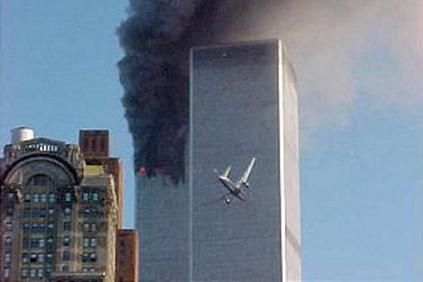


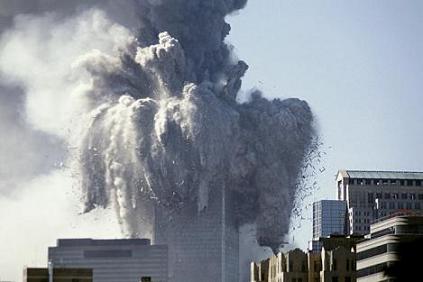
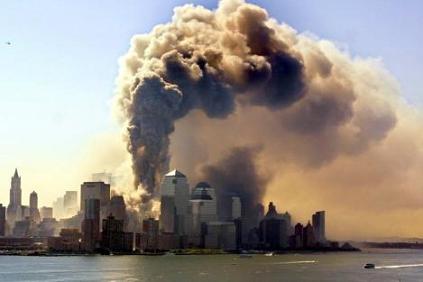
9/11 (2007) Nahr el-Bared
Six years later and thousands of Miles east of NYC - in Lebanon
The nearly four-month struggle of approximately 200 Fatah al-Islam "resistance fighters" (Campo Antiimperialista) against "Imperialism, the Zionist world conspiracy" and the "Empire" itself ("The Near and Middle East - War, Occupation and Resistance", Pahl-Rugenstein 2007) led to the complete termination of the northern Lebanese town Nahr el-Bared - before home for more than 30,000 Palestinian refugees - by the Lebanese Army (backed by the USA/CIA, France, Germany..). But of course today, just few days after the final battle, nobody is talking about it anymore!!
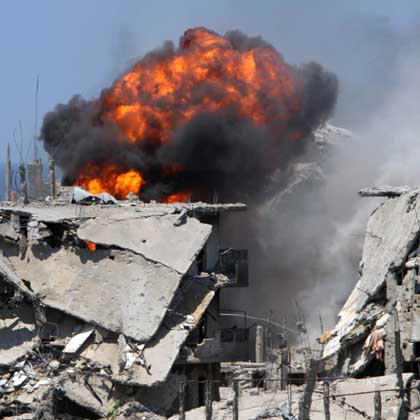


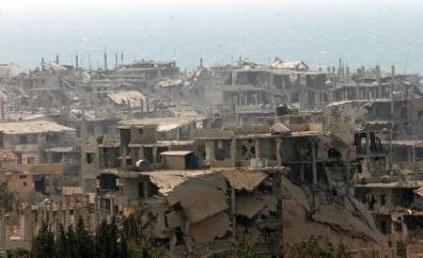
Since 50 years (parts of) the German progressive/peace movement is demonstrating on the 1st of September (the date marks the begin of WW II, with the German attack against Poland, 1939.9.01) against war. But - at least since the NATO war against (the former) Yugoslavia - also German neo-nazis/fascists are trying to occupy that date for their own interests (extreme anti-Americanism/"anti-imperialism", anti-semitism etc.).
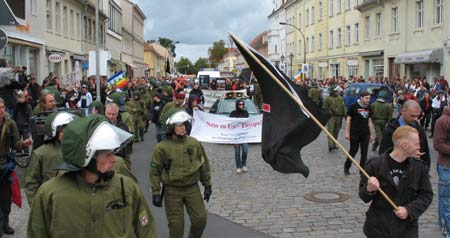
So yesterday in the northeast German town Neuruppin neo-nazis/fascists demonstrated against "imperialist wars" and demanded solidarity for the "Resistance in Iraq", "Hamas - the main liberation movement against the world Zionism", "Against War and Capitalism - Forward to the National Socialism!" etc.
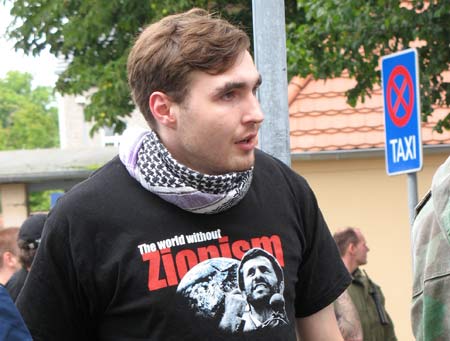
T-shirt "Made in Iran"
During the final speech, like it was written on many pickets, they called for solidarity with the ('national-socialist') "un-defeatable North Korea in its struggle for freedom.."
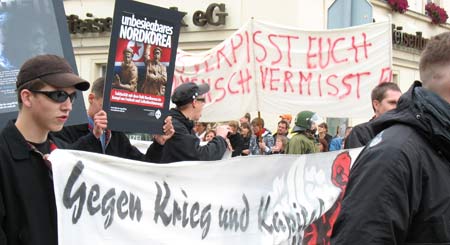
"Un-defeatable..
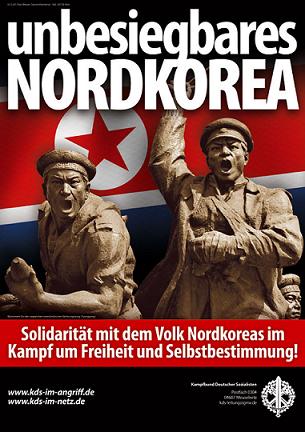
..North Korea"
For more pics about y'day's fascist "anti-war" demo please check out:
http://www.adf-berlin.de/html_docs/gallery/2007/neuruppin_01_09_2007/neuruppin_01_09_2007.php
First of all: Despite contrary news from yesterday "the US is considering a military solution of the hostage crisis in Afghanistan", according to the German (bourgeois) daily newspaper Die Welt. Only three days ago the German Der Spiegel predicted that if that will be happen "diplomats and political analysts are expecting - with a high probability - a blood bath" (i.e. all the hostages will be messacred)..
It seems that - at least in the opinion of the S.K. bourgeois media - a new wave of anti-Americanism is now spreading across S. Korea, at least in the "progressive" parts of the society (☞ S. Korean civic groups blame U.S. for hostage crisis, Yonhap, 8.03).
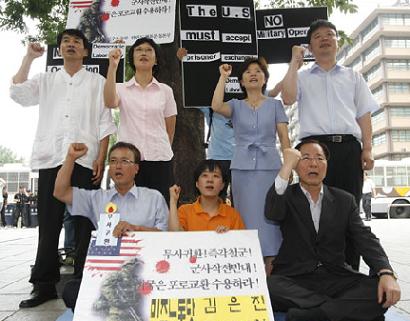
About ten days ago a S.K. netizen wrote following on Korean Action against Dispatch of Troops to Iraq/파병반대국민행동:
Afghanistan resisters are holding korean missionaries and claiming withdrawal of korean troops. This terrible incident was made by korean government’s dispatch policy.
Now the situation is pushing President Roh Moohyeon to abyss. His politic crisis prevents him from forcing policy of dispatch not like 2003 year(He killed Kim Seonil by forcing dispatch troops in Iraq, 2003). So there’s a chance to save the victims. We should organize anti-war actions, claim withdrawal, save missionaries.
In this concern, a student questioned that “Isn’t it a fault of the missionaries, who using occupation of US army to mission Afghanistan people?”
He saw this argument in a newspaper. Today morning, korean right-wing newspapers insisted this kind of distortion, a distortion that it’s not about dispatch of Korean troops, but about religion.
We should make anti-war actions against this kind of distortion.
Yeah (even I don't agree with everything) there must be a MASS MOVEMENT!! But when 200 or 300 people are holding a candle light rally near Gwanghwamun.. That's definite NO mass movement - it will change complete NOTHING!!!
BTW 1: For me the Taliban (but also the majority of the Iraqi "resistance") are only representatives of the most reactionary way of oppression!
BTW 2: (Just) anti-Americanism(*) is also reactionary, at least complete stupid..
BTW 3: * but it can be used - uhuu~ I'm sorry! - for (eeh, more about it later^^)..
Well, in my opinion Hankyoreh is right when it said before y'day that "..Karzai’s government in Afghanistan is a creation of the Bush administration. The Afghan government depends on the U.S. administration" - complete on the US and NATO occupation forces.
The S.Korean gov't has definite no power to demand anything from the Afghan "gov't"! But the USA, together with the other NATO states, who are involved of the ongoing war there, have the power to force the Afghan "gov't" solve the hostage crisis - and it includes a possible prisoner swap - peacefully.
But only a S.K. mass movement is able to create a kind of pressure against its own gov't and on that way against the US administration.. (Don't forget that S.K. is the closest ally of the USA in Asia!!)
On the other side - if I understand it well - the ruling class (at least in S.K.) is already seeing the (possible) danger of such an development and react with counter measures, such as a (massive?) media campaign (likely supported by some/THE reactionary Christian forces): ☞ Hostage Families Reject Anti-American Rallies (Chosun Ilbo, 8.03)

Yesterday (8.01) "Taliban 'Spokesman' Talked Exclusively to Chosun Ilbo":
A purported spokesman for the Taliban on Tuesday said the Islamist militants killed a second Korean hostage because there was no response to their four-hour extension of the deadline for negotiations. Qari Yousuf Ahmadi, who has been talking to the international press in various hostage situations, made the claim in an exclusive interview with the Chosun Ilbo. He said the kidnappers randomly picked Shin Sung-min for killing and threatened the death of more hostages unless there is prisoner exchange by noon on Wednesday...
―Why did you kill the second hostage?
"We had extended the deadline for negotiations from 12:00 noon to 4:00 p.m. But we didn't hear any good news. So we killed him around 8:30 p.m."
―What exactly is the Taliban's demand?
"We demand 24 Taliban prisoners are released in three steps, eight in each step."
―Why do you insist on a prisoner exchange in three steps?
"This is the way each side can trust the other. We want to see if eight Taliban prisoners can be exchanged with hostages, as we demand, in the first place.
―You released a video of the hostages today. Are you going to release another?
"It was videotaped by a Taliban fighter who supervises hostages and delivered to Al Jazeera. We decided to ban interviews with the media from today. We believe that through the voices of hostages, the Taliban's demand became known fully to Korea and the entire world."
―How are the Korean hostages?
"Seventeen to 18 of them are sick. They don't seem to adapt to the climate well. And they don't seem to eat well, either."
―Please allow us to deliver medicines to the sick people first.
"The Taliban don't want medicine but a prisoner exchange. Then they can all go home. We are not a hospital. We have no reason to treat them." (*)
http://english.chosun.com/w21data/html/news/200708/200708010015.html
* Medicines? What for?? Today's K. Times: "16 Korean Hostages Sick". Harrharr.. (eeh~ I'm really sorry!!)
Related articles:
☞ Politicians, Civic Groups Blame U.S. for Hostage Crisis (Chosun Ilbo, 8.02)
☞ U.S. holds key to hostage crisis in Afghanistan (Hankyoreh, 8.01)
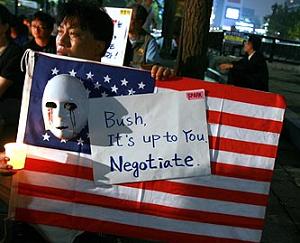

Related:
☞ Korean hostage crisis (CNN video, 7.27)
☞ Does Korea really see the world as it is? (Hankyoreh, 7.26)
☞ Afghan hostage crisis transfixes South Korea (IHT, 7.26)
PS:
Few days ago Qari Yousaf Ahmadi, spokesman of the Taliban, said the 'resistance fighters' know well the 23 Korean Christians visited Afghanistan in order to convert pure Muslims to Christianity, according to New York Times. "If they were not women, they would have been killed when captured," Ahmadi said.

December 2001 - short after the ("official") destruction of the Taliban rule by the US/NATO forces the West promised the people of Afghanistan: "PEACE, FREEDOM, DEVELOPMENT, PROSBERITY.."
Now, just two month ago (5.29) and nearly six years later the UN Office for the Coordination of Humanitarian Affairs published following smal excerpt of the daily reality in Afghanistan:
Opium abuse harming women’s, children’s health
Sadaf started consuming opium seven years ago after she could not find any medicine to overcome a headache that had bothered her for weeks. “When I first smoked opium I felt dizzy for a while, but did not have a headache - so I continued,” the mother of four told IRIN in the Yamgan District of Afghanistan’s northeastern Badakshan province.
Sadaf smokes locally produced opium with a tiny hookah three times a day with her children huddled around her. In the intoxicating atmosphere of the mud hut filled with opium smoke there is no chattering by her children; they look dazed and silent.

Sadaf and Bibi Mullah smoke opium thrice a day
Grabbing the head of her four-year-old son who has pneumonia, the mother puts a blowback of smoke into his mouth and puffed a second breath at his face. “I do this to make him calm and sleep well,” Sadaf said to justify her actions.
Fanila Zaki, a health worker in Badakhshan, said many such children suffer from acute respiratory diseases caused by frequent exposure to opium smoke.
“Some mothers think when their children do not cry and sleep they are fine,” said Zaki, “but that is simply incorrect and misleading”.
High maternal mortality
With some 1,600 mothers dying per 100,000 births, Afghanistan has one of the worst maternal mortality rates in the world, officials at the United Nations Population Fund (UNFPA) office in Kabul said.
In Badakhshan, 6,500 mothers out 100,000 die while giving birth - the highest maternal mortality rate in the world, the UN agency says.
Opium abuse exacerbates the situation, specialists say. Women who consume opium during pregnancy lose much of their energy and become vulnerable to different diseases, the provincial health department reported.
“Most addicted mothers suffer from asthma, coughing and lung problems which make them very weak to endure the burden of pregnancy,” a local health worker said.
Health workers say some addicted mothers also loose the chance of a future pregnancy because opium addiction damages their uterus.
Financial burden
I sold my land in order to afford my addiction.
Addiction has put a heavy financial burden on many poor families, plunging them deeper into poverty and social insecurity.
“I’ve been spending 200 Afghani [US$4] on opium every day for the past seven years. I sold my land in order to afford my addiction,” another addicted woman, Bibi Mullah, said.
Badakhshan, one of Afghanistan’s most isolated, underdeveloped and poverty-stricken provinces, has a rugged terrain that impedes movement in its sparsely populated districts.
There is no official data about the number of drug addicts in Badakhshan. However, the United Nations Office for Drugs and Crimes (UNODC) says one million people have drug addiction problems in Afghanistan of which 45,000 are women.
Poor health service
According to Mohammad Alim Yaqoobi, head of the UNODC office in Badakhshan, the majority of people in Badakhshan lack access to health services and awareness about the harm of opium addiction.
“People tend to consume opium as a painkiller. It takes time until they actually realise that opium itself is a disease and that they are addicted to it,” added Yaqoobi.
Locals in the district say if health services were provided they would not use opium as a substitute for medicine.
In Yamgan and many other districts of Badakshan, donkeys are the only means of transport for the locals. A resident of Jokhan village in Yamgan District needs two days, either on foot or by donkey, to reach the nearest medical facility. Opium is thus considered a readily available option.
UNODC has been working in Badakhshan to raise the awareness of local population about the risks associated with opium addiction.
However, given the high rate of illiteracy in the estimated 900,000 population of Badakhshan, it is very difficult to maintain a robust public information campaign. Some 3,730 opium-addicted individuals who had received treatment in Badakhshan resumed opium consumption shortly after the rehabilitation, according to UNODC.
http://www.irinnews.org/Report.aspx?ReportId=72419

While nearly all int'l "important"(i.e. bourgeois, of course..^^) news agencies/TV stations were/are reporting about today's "peace making event" (CNN/World News Asia) at the DMZ, A. Vershbow, the US ambassador in Seoul (i.e. the Bush administration) yesterday warned the SK government "that the United States wants Seoul not to speed up the inter-Korean reconciliation".
Yo, you f.. idiot, shut up! That's not your business!!!
Hankyoreh wrote today about it following:
☞ On inter-Korean relations, U.S. officials say, ‘slow down’
And Korea Times:
"U.S. Ambassador to Korea Alexander Vershbow stressed close coordination between Seoul and Washington on inter-Korean reconciliation Wednesday, one day before South and North Korean trains are to cross the Demilitarized Zone (DMZ)..
His remark is widely interpreted here as meaning that the United States wants Seoul not to speed up the inter-Korean reconciliation.."
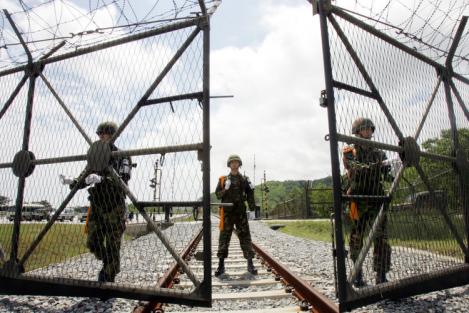
About today's inter-Korean train event CNN, as its THE TOP STORY, wote:
☞ Koreas make tracks towards peace

More about it you can read here:
☞ Trains carry nation's hopes for future (K. Herald)
☞ DMZ train tested, but no ‘All aboard!’ foreseen (JoongAng Ilbo)
☞ Koreas hold historic rail crossing (al-Jazeera)
☞ First Trains in 56 Years Cross Inter-Korean Border (Chosun Ilbo)
☞ Inter-Korean train lines tested, so what now? (Hankyoreh)
☞ In Pyongyang, all is silent regarding train test
☞ "A New Era in North-South Relations" (VoP, incl. video report)
Some - partly nice/interesting - pics about the event you can see here:
☞ First Time in 56 Years, S-N Korea Trains Depart (DailyNK)
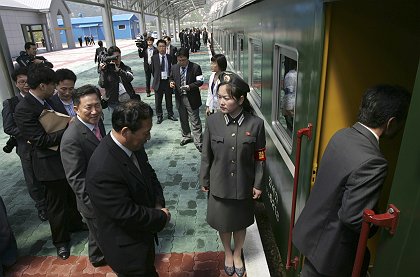
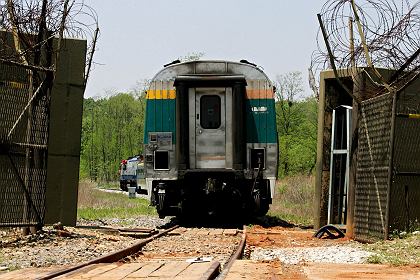

The SK semi-official news agency Yonhap published today following feature:
Rare experience aboard N. Korean train across the border
At the urging of North Korean conductors, 100 South Koreans and 50 North Koreans boarded a five-car train at 11:25 a.m. With no speaker system at Kumgangsan Station at the North's scenic mountain along the east coast, conductors repeated "Please board the train" through a loudspeaker mounted upon a South Korean-made Hyundai Starex utility vehicle.
Painted green on the main body and the roof a faint gray, the facade of the train was far from modern. "The train looks like South Korea's obsolete third-class train, but its ability is better than that," said Lim Jong-il, a South Korean official at the Ministry of Construction and Transportation.
South Korean Construction Minister Lee Yong-sup, Kim Yong-sam, the North's railway minister, and some 20 South and North Korean journalists crowded into the second car of the train. The smell of new paint assailed the nostrils upon ascending the steps, while a pair of portraits of Kim Il-sung and his son Kim Jong-il hung on the wall above the door.
The seating arrangement was face-to-face, and refreshments for passengers were set on a small table in front of the window -- one lemon-lime soda, one strawberry juice, one bottled water, two apples and a pear. North Korean female attendants served a cup of ginseng tea for passengers later.
The upright, ivory-colored vinyl seats were a little bit uncomfortable and did not recline, but the cushions were softer than they appeared to be.
Outside the window, a uniformed North Korean conductor waved a red flag and goose-stepped past the train, which signaled the impending departure. A few North Korean security officers came inside to check the number of passengers and asked journalists jostling for position to sit down.
At 11:27 a.m. a long whistle sounded, reminiscent of an old-time steam locomotive. The train spluttered back and forth several times and then slowly started forward. "North Korean trains usually whistle a lot," a South Korean transportation official said.
North Korean middle school students, who attended a ceremony, started to wave their hands, and South Korean passengers responded in kind. The train moved out of Kumgangsan Station at the speed of 10 kilometers per hour, and North Koreans working nearby just looked at the train without reacting in a friendly manner.
Some 50 meters away from the railway on the right side, a paved road appeared as the scenic Mount Geumgang faded from sight. Rice paddies were waiting for rice seedlings to be planted, but no peasant was seen working outside.
Unexpectedly, well wishers were South Korean tourists traveling to the Mount Geumgang resort in a convoy of eight buses. "At this time of the day tourist buses go to the resort," a South Korean official said.
At 11:30 a.m. the stretch of hills and mountains continued, and the clouds moved quickly against the blue sky, cleansed from the previous day's rain.
A few Toyota jeeps driven by soldiers, military jeeps and trucks drove parallel with the train and then fell behind. North Korean soldiers were stationed at the checkpoints of major intersections.
Then the track turned sharply, a rare occurrence on South Korean track. The sharp turns came again and again, and a woman peeked outside the window at a nearby village.
The overall atmosphere was friendly, a throwback to a picnic in the 1970s-80s on a slow, squeaking train. Hills and mountains passed by, and splendid pine trees of all kinds of shapes. After awhile the Nam River appeared on the right side of the train. At one village, some 10 residents came out and looked over the communal wall to watch the passing train.
At 11:50 a.m. the train passed Samilpo Station. The painted name on the station was very small, like Kumgangsan Station, and an oversized portrait of Kim Il-sung hung on the front of the station, along with pro-communist and cult propaganda slogans.
The train crossed the river on a bridge restored with steel plates provided by South Korea. Outside the window, North Korean tourist attractions such as Haegumgang and Samilpo were seen a little farther away.
At 11:50 a.m. some passengers pushed up the windows, and the unpolluted air coming through the open windows refreshed them. A group of 10 North Korean soldiers stood guarding a storage house of diesel engine trains built for the railway test run. There was no other train in sight.
The train slowed down at Kamho Station, where North Korean customs officials were stationed. It was 11:55 a.m.
Around 12:00 p.m. four customs officials and two conductors boarded each car of the train. One of them shouted, "We fervently welcome you who have become the first passengers of the train! Now we will start customs clearance procedures."
Conductors checked the identities of the passengers and digital cameras. They asked a passenger to delete a photo of portraits of Kim Il-sung and Kim Jong-il that had been blurred from the shaking of the camera.
At 12:15 p.m. the conductors suddenly moved to the exit and disembarked. They must have gotten orders to let it pass, as the inspection took longer than expected. The train started to move again right away.
"Now you will see an outpost about 200 meters. It is the Military Demarcation Line," said Kim Kyong-jung, chief of the inter-Korean railway team at the Ministry of Construction and Transportation.
A sharp whistle blew, and the train picked up speed, double its previous pace. The shaking was palpable, but not enough to affect the bottles on the small table. With the speed increasing, the frequency of the whistle's call also increased.
In five minutes, the train passed the Northern Limit Line and went into the Demilitarized Zone. At 12:21 p.m., it passed the Military Demarcation Line to roars of applause. The train slowed a bit and the passengers became quiet, awaiting arrival.
At 12:25 p.m., a South Korean tourist observatory appeared, and some 200 tourists on the porch waved their hands eagerly, welcoming the North Korean train. Wide paved roads came into view and the train arrived at Jejin Station five minutes later. Amid the loud sound of a welcoming brass band and the cheering crowd, the train stopped at a South Korean station for the first time in more than half a century.
http://english.yna.co.kr/Engnews/20070517/480100000020070517193348EP.html

Following - in my opinion - very interesting, if not to say significantly ('cause it's complete without nationalist, pro-NK stuff) article has been published in yesterday's Hankyoreh:
How can a peace be achieved on the Korean Peninsula?
Building a permanent peace regime on the Korean peninsula is long-cherished dream of Koreans who underwent terrible sufferings and devastating damage during the Korean War which broke out in 1950. Permanent peace is considered to be the only way to avoid another war on the Korean peninsula. If war breaks out again, the consequences would be disastrous. The existence in Korea of a national consensus on the need for a solid peace framework, a consensus that supersedes political affiliations, is indisputable.
Even though more than five decades have passed since the Korean War ended, the two Koreas are still technically at war each other. Three countries signed the armistice; North Korea, the U.S. and China. South Korea did not join in. Then South Korea President Syngman Rhee refused to sign the document, arguing that an armistice would remove the chance to reunify Korea.
Since then, it is North Korea which has consistently been calling for negotiations for a peace treaty with the US. The main goal of North Korea's peace initiatives was eventual withdrawal of the U.S. forces from South Korea. North Korea perceived that the military presence of the U.S. in South Korea posed a serious threat. But North Korea's demands were simply rejected by the United States because North Korea insisted that South Korea be excluded from the peace treaty negotiations. North Korea argued that south Korea is not entitled to join peace negotiations because South Korea was not a signatory to the armistice. North Korea has not changed its stubborn position on who should be the principal participants in the peace talks.
When the four-party talks convened in 1994 to discuss North Korea's nuclear program, North Korea reiterated its position that South Korea shoud be excluded. As North Korea's nuclear disputes intensified, South Korea and the US reversed their position on peace talks. The two countries are very eager to embark on talks even though they attach preconditions for them. One precondition is North Korea's repudiation of nuclear weapons programs. Top leaders of the two countries emphasize that they are ready to start peace talks if North Korea would abandon its nuclear ambitions. The US links the denuclearization of North Korea to the peace agreement. On the other hand, South Korea was greatly anxious to reach a peace agreement as part of its efforts to avoid war on the Korean peninsula and to pursue stability and co-prosperity.
When tensions over North Korea's nuclear program escalated, support for peace regime gained momentum among decision-making circles in both South Korea and the United States. The peace mechanism is considered useful in diffusing tensions on the Korean peninsula. South Korean leaders seemed to have the view that North Korea's nuclear disputes could be resolved only in the context of a comprehensive peace framework. From this viewpoint, the denuclearization of the Korean peninsula could be realized only through establishment of the permanent peace mechanism.
In the United States, officials at State Department and the White House began to pay attention to the effectiveness of the peace regime on the Korean peninsula. They realized that the peace regime could serve as another multilateral forum to persuade North Korea to give up the nuclear weapons program. Philip Zelikow, foreign policy consultant to Secretary of State Condoleeza Rice is known to play a leading role in conceptualizing the peace regime. Zelikow reportedly advised Secretary Rice to push ahead with the peace formula.
It was again this backdrop that South Korean President Roh Moo-hyun and US President George W. Bush agreed in a summit held Nov 17 2005 in Gyeongju, a city of southeastern Korea, "to make common efforts to develop a regional multilateral dialogue and a cooperation mechanism so as to jointly respond to regional security issues."
The two leaders reaffirmed their commitment to the peace regime when they met on the sidelines of the APEC summit in Hanoi in November 2006, a month after North Korea conducted a nuclear test on October 9, 2006. At the meeting, Bush disclosed that he has the intention to sign an agreement officially declaring the end of the Korean War together with South Korean President Roh and North Korean leader Kim Jong-il.
Since then, the peace regime has gained momentum. In the six-party talks, agreement was reached twice (in September 19, 2005 Joint Statement and in the February 13, 2007 Agreement) to set up a separate forum to discuss a permanent peace mechanism on the Korean peninsula.
At this point, the separate peace forum remains to be launched due to the tug-of-war over North Korean money frozen at the BDA account in Macau. When the follow-up working group negotiations start, the peace forum will get started.
Before moving on to how to build a permanent peace regime on the Korean peninsula, let us talk about what major source of tensions and hostilities which could imperil the peace on the Korean peninsula?
Fundamentally, the division of the Korean peninsula after World War II is often cited as a primary source of tensions and hostilities on the Korean peninsula. Two Koreas fought each other in the Korean War. For a long time, North Korea's military threat has been considered as a major factor in tensions. In this context, reunification of the divided Koreas would lead to peace on the Korean peninsula.
However, the security situation in Korea underwent a sharp change after the end of Cold War, symbolized by the dramatic collapse of the Soviet Union and a number of East European communist countries. Since then, the threat from the isolated and poor North Korea has diminished significantly. Even though North Korea now posseses nuclear weapons (or devices), few South Koreans feel the North is a serious threat.
The North is widely believed to be incapable of sustaining warfare even though it strikes first against South Korea. North Korea's long-time ally, China, is unlikely to support North Korea's possible war against South Korea. In view of its poor economic performance and sheer diplomatic isolation, North Korea is unlikely to turn to military adventurism. Launching war on South Korea would be military suicide.
Rather, North Korea seemes to worry about the possible military attacks by the United States since President George W. Bush took power in 2001. In particular, North Korea appeared to feel a serious threat from the U.S. since President Bush branded it a member of the "Axis of Evil" in his 2002 State of the Union address. As a matter of fact, the U.S. did not rule out the possibility of a "preemptive strike" against North Korea as part of its efforts to remove nuclear facilities in North Korea. Top leaders of the US made it public that "all options are on the table" to resolve the North Korean nuclear cirsis. In this sense, hostile relations between the US and North Korea constituted a major source of deteriorating instability and growing tensions in the Korean peninsula.
The primary motivation behind the Bush administration's hostile policy toward North Korea during its first term rested with its repudiation of Clinton's engagement policy toward North Korea. President Bush's North Korea policy, which was dominated by hawkish key figures like Vice President Dick Cheney and Secretary of Defense Donald Rumsfeld, was characterized as ABC(Anything But Clinton). The Bush administration had been pursuing eventual regime change of North Korea until it finally decided to start one-on-one negotiations with North Korea in Berlin in January of this year.
Tensions culminated in North Korea's nuclear test which was conducted on Oct 9, 2006. To sum up, hostilities and distrust between North Korea and the US combined to escalate tension in the Korean peninsula. There is no doubt that North Korea's nuclear weapons are escalating tensions in the Korean peninsula and East Asian region. Japan may feel tempted to develop nuclear arms to have a deterrent against North Korean nuclear weapons. Taiwan will continue to observe what's happening with the North's nuclear program. These scenarios are the worst ones China could possibly imagine. Sometime in the future, South Korea may try to possess nuclear weapons as well. A nuclear arms race will be inevitable if North Korean nuclear weapons are left unchecked.
Another source of tension in the Korean peninsula is the Sino-Japan rivalry in East Asia. Mindful of rapid rise of China's influence in the region, Japan has been building up its military power. Japan may justify its military buildup as self-defense against North Korea's nuclear weapons and long-range missiles. Japan has been exploiting North Korea's nuclear threat as a pretext for rearming itself as well as pushing for a revision of Article 9 of its constitutional to allow it the right to wage war and maintain legitimately armed forces. But it is widely believed that Japan's military buildup is aimed at its archrival China.
How can peace be achieved on the Korean peninsula? Considering the fact that hostile relations between North Korea and the US constitute a major obstacle to the peace in the Korean peninsula, normalization between the two countries would be indispensable. The North Korean nuclear crisis grew critical as the Bush Administration engaged in explicitly hostile posture against North Korea.
The Atlantic Council peace regime report released on April 13 this year deserves attention. The report is credited with a comprehensive approach to the blueprint for the peace framework. It includes five major points for the peace formula.
First, the report calls on the Bush administration to agree to a "denuclearization agreement." Second is to replace the armistice of 1953 with a "four-party" agreement between the two Koreas, the US and China. Third is for the US to sign a bilateral agreement with Pyongyang to settle outstanding legal and political issues. Fourth is to negotiate a trilateral agreement with both Koreas for the sake of confidence-building measures between the military forces, as a step toward the four-party agreement. Fifth is to work on establishing a multilateral organization for security cooperation in Northeast Asia modeled after Organization of Security and Cooperation in Europe.
The report is the first of its kind to present detailed and concrete steps to reach a full-fledged peace framework on the Korean peninsula rather than focusing entirely on the North Korean nuclear issue. In the past, former President Kim Dae-jung also proposed the peace formula shortly after he took office in 1998. His main concept was for both Koreas to sign a peace treaty with full supports from the U.S. and China.
Both South and North Korea have been seeking to diffuse tension and achieve national reconciliations. This effort dates back to 1972 when the two sides declared historic 'July 4 Declaration' which set out broad principles of Korean reunification. The three main pillars of the Declaration were national self-determination, peace, national solidarity.
The July 4 declaration came in the wake of the so-called Nixon shock. President Nixon's surprise visit to Beijing and the historic Shanghai Communique which paved the way for normalization between the U.S. and China shook the whole world. In particular, South and North Korean leaders were greatly astonished by detente and subsequent cross-recognitions between the US and China.
From this viewpoint, the July 4th Declaration was a response to the sudden Sino-US detente. However, inter-Korea detente did not last long. Each side exploited it as a chance to strengthen autocratic rule in each country. North Korean leader Kim Il-sung was able to become ruler for life. In the South, Park Chung-hee established himself the unchallenged dictator with the Yushin Constitution, allowing himself limitless power. Unfortunately, the first inter-Korea detente led to more harsh authoritarian rule in each side.
About two decades later, South and North Korea reached a historic peace pact known as "Basic Agreement" on December 13, 1991, which became effective in February 1992. It called for both governments to endeavor together to transform the present state of armistice into a solid peace between the two sides. Unlike the 1972 pact, the Basic Agreement outlined a number of security-related CBMs (confidence-building measures) as well as various measures concerning North-South reconciliation, non-aggression, exchange of people and economic cooperation. Together with the Basic Agreement, two Koreas created the "Declaration on the Denuclearization of the Korean Peninsula." It forbade both sides to test, manufacture, produce, receive, possess, store, deploy, or use nuclear weapons and forbade the possession of nuclear reprocessing and uranium enrichment facilities. A procedure for inter-Korean inspection was to be organized and a North-South Joint Nuclear Control Commission (JNCC) was mandated with verification of the denuclearization of the peninsula.
How to build a permanent peace regime on the Korean Peninsula? What is a peace regime? Is it simply to end the state of war officially by replacing 1953 armistice with a peace agreement(treaty)? A peace agreement alone would not end hostile relations and possibilities of war. The peace regime should involve a whole set of country-to-country and people-to-people relationships, by which peaceful coexistence and co-prosperity could be achieved on the Korean peninsula.
Both South and North Koreas have already produced a significant peace mechanism 15 years ago, 1992, widely known as Basic Agreement. The Basic Agreement contains almost everything when it comes to peace frameworks on the Korean peninsula. The basic spirit is reconciliation, peace and exchanges. It deserved to be called as textbook of Korean peace mechanism.
However, it lacks one crucial element. It did not secure full support from key stakeholder countries which affect the security of the Korean peninsula, that is the U.S. and China. The two countries were entangled in the Korean War and fought against each other. As a matter of fact, the Basic Agreement was invalidated when the first North Korean nuclear crisis surfaced in 1994. The first North Korean nuclear crisis could be settled down when the U.S. and North Korea reached the Agreed Framework in 1995. However, the Agreed Framework was also nullified when the Bush Administration killed it in 2002, alleging that North Korea had not live up to the Agreed Framework by seeking to operate covert highly enriched uranium (HEU) program. The foiled Agreed Framework left a valuable lesson: peace frameworks would work only when revelent countries like the U.S. and China are involved as principal partners.
What shoud be done for a permanent peace on the Korean peninsula? As many experts and scholars point out, it is no doubt that improved ties between the U.S. and North Korea would be a first step toward the full-fledged peace regime on the Korean peninsula. In this context, the peace mechanism would require "grand bargain" package.
Measures that would be included in the package are:
1. To replace the 1953 war armistice with a peace treaty (or peace agreement). The principal partners would be the two Koreas, the U.S. and China.
2. To normalize relations between North Korea and the U.S. Hostile relations between the two countries have been a major source of tensions and instability on the Korean peninsula.
3. To achieve nuclear disarmament on the Korean peninsula. The first step would be North Korea's abandonment of nuclear programs.
4. To carry out confidence-building measures such as redeployment of forwardly deployed ground forces along the Military Demarcation Line which divides South and North Korea. Reduction of conventional forces are also followed as part of confidence-building measures.
5.To set up a multilateral security and cooperation organization in Northeast Asia.
6.To build a Northeast Asia Nuclear-Free Zone.
7.To establish an energy-cooperation mechanism under which Russia's natural gas is supplied to both Koreas, China and Japan through pipelines to be built to connect these countries.
In the context of Northeast Asia's regional security, a multilateral security organization and a Nuclear-free Zone are vital. In view of the fact that regional security could not come automatically even when North Korea dismantles its nuclear facilities fully.
What's needed to take place is a new approach to a permanent peace framework for the Korean peninsula as well as regional stability in Northeast Asia. The two goals cannot be separated. In particular, the economy of Northeast Asian countries are highly interdependent. The security of the region is also closely linked as well.
For its part, North Korea needs to change. As long as the so-called "military-first" ("Songun") structure of North Korea remains unchanged, it would be highly difficult, if not impossible, for North Korea to give up the nuclear weapons it might have produced.
Militaries always tend to maintain tension and military confrontation. North Korean leaders should realize that the time when military power alone is enough for defense is gone. History shows that military power cannot guarantee its survival. It should adapt to the global trend, which calls for a more open society and higher standards of human rights.
http://english.hani.co.kr/arti/english_edition/e_editorial/208361.html
Somehow(^^) related:
☞ Two Koreas agree on rail test, tension-reducing measures (Yonhap, 5.11)
☞ Two Koreas agree on train crossing, but just this once (JoongAng Ilbo)
☞ South Korea, US Differ Over Peace Treaty Timeline (Korea Times)
Only few days before his mission as occupier in Iraq Prince Harry, according to the German (bourgeois) magazine Der Spiegel, already wrote his testament/last will..(^^) "And, as he said to friends, he will miss his family very much" (Spiegel, 4.29). But perhaps very soon he will not only miss his family, but also his ears, if we really want to believe the promise of the Iraqi resistance (once again: ^^).
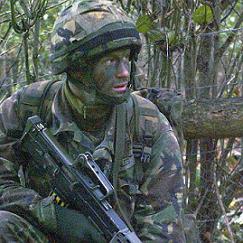
The British newspaper The Guardian reported following yesterday:
Iraq militia: we have special unit
to target Prince Harry
Shia commander claims insurgents have plan to capture royal officer
Prince Harry will be a prime kidnap target for insurgents in Iraq, a commander in the Mahdi army, the Shia militia loyal to the radical cleric Moqtada al-Sadr, has told the Guardian.
"One of our aims is to capture Harry, we have people inside the British bases to inform us on when he will arrive," claimed Abu Mujtaba, who commands a unit of around 50 men active in the Mahdi army in Basra.
In comments denounced by British defence sources as "blatant propaganda", Abu Mujtaba told the Guardian: "We have a special unit that would work to track him down, with informants inside the bases.
"Not only us, the Mahdi army, that will try to capture him, but every person who hates the British and the Americans will try to get him, all the mujahideens in Iraq, the al-Qaida, the Iranians all will try to get him."
The Guardian has seen evidence that Abu Mujtaba has a number of men under his command as well as weaponry including rockets, but there is no independent evidence to substantiate his claims that militias have infiltrated British bases, or established a unit to target Prince Harry.
Abu Mujtaba continued: "For me he is just a British soldier and he should be killed if comes to Iraq, but let's be realistic, we can kill hundreds of British soldiers before forcing them to withdraw - like what's happening with Americans now - but Harry is a bigger catch and we will force the British to come on their knees and talk to us."
A senior Iraqi defence ministry official said that militias could overrun Basra relatively easily because they had successfully infiltrated local security forces. "When the Brits formed these forces they depended on these militias for lists of recruits," he said.
Responding to the threats against Prince Harry, a British defence source said: "This is blatant propaganda from those who aim to tear Iraq apart. These threats will not prevent British forces from doing their vital work of building up the Iraqi security forces and helping them to face down those perpetuating violence against the Iraqi people."
The Ministry of Defence yesterday maintained its previous official line, that Prince Harry's deployment on a six-month tour to south-eastern Iraq with his regiment, the Blues and Royals of the Household Cavalry, was under "constant consideration". It added: "It remains our intention that Prince Harry will be deployed as a troop leader."
The Blues and Royals are part of a mechanised brigade to be deployed next month. They will carry out reconnaissance using armoured cars. Reports that an attack by a roadside bomb on an armoured vehicle in Maysan province last week that killed two British soldiers was a "dry run" for an attempt on the prince's life were treated with scepticism yesterday by senior defence sources. However, it was the first time British soldiers have been killed in that type of vehicle in south-eastern Iraq by hostile action and security has been stepped up in the areas where the Blues and Royals will be based.
Defence officials and military commanders are becoming agitated by the intense media coverage of Prince Harry's planned deployment. They argue that it encourages insurgents and militia in Iraq to escalate their propaganda war as well as increase the risks surrounding the prince's deployment. Commanders are concerned that the deployment may increase the threat to all his regimental colleagues, and even to all British troops in the area...
http://www.guardian.co.uk/Iraq/Story/0,,2067593,00.html
덧글 목록
관리 메뉴
본문
all killing and violence is wrong, and should never be condoned or celebrated, right?부가 정보
관리 메뉴
본문
(fantastic blog btw, really good reading! i hope you continue to upload lots/regularily :-))부가 정보
관리 메뉴
본문
도토리: 1. 고맙습니다!!2. of course violence/terror against the "ordinary" people, like what is happen right now in iraq (for example) we should/must fight against!! it's enough that the class enemy daily is using violence, in many different ways, against us/the oppressed class (actually many parts of the iraqi "resistance" i see also as our common class enemy..).
부가 정보